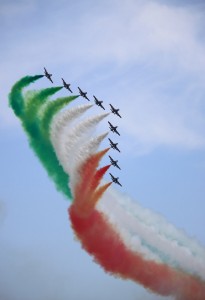
©Bigstock.com/Alessandro0770
Signing the Armistice of Villa Giusti on 3 November 1918 ended World War I for Italy. The following year, a public holiday was introduced on November 4th to commemorate this monumental event as well as all fallen soldiers: Giorno dell’Unità Nazionale e delle Forze Armate, which roughly translates to “Day of National Unity and the Armed Forces”. While not a day off work today and instead celebrated on the following Sunday, November 4th had lost meaning after the reform of the Italian public holiday calendar until being rediscovered in the early 2000s.
Dissolution of the Italian Front
After the devastating defeat during the Twelfth Battle of Isonzo in October/November 1917, the Italian Armed Forces were pushed back to the Piave River. While the Entente scored decisive victories at other fronts, Austria-Hungary was doing exceptionally well at the Italian Front even though the troops suffered from supply issues and the Habsburg Monarchy had to battle political unrest. Delayed by severe rainfall and flooding, the critical battle of the Italian Front during World War I began on 24 October 1918. Its site: Vittorio Veneto bordering the Northern Italian lowlands.
Supported by French and English troops, the Italians gradually managed to conquer large parts of Friuli and Trentino benefitting from the political collapse of the Habsburg Monarchy. The Hungarian administration had already recalled their troops on October 24th to protect the southwest of the country. The actual dissolution began four days later. First, Czechoslovakia was founded. Next, several other states left the monarchy and joined what would later become Yugoslavia. Hungary’s exit from the Habsburg Monarchy on October 31st formally dissolved Austria-Hungary. Austria sought a quick armistice, which was signed on 3 November 1918 at 3 pm in the villa of Count Giusti del Gardino coming into effect exactly 24 hours later. Combats on the Italian Front had officially ceased.
November 4th now and then
It was only a year after the war had ended that November 4th became a nationwide holiday. Having been exploited by the fascist regime for some years, it regained its original named after World War II to show solidarity with the troops. November 4th used to be a work-free holiday until 1976 before being moved to the first Sunday in November after the reform of the Italian holiday calendar the following year. At the same time, November 4th had begun to lose its significance after the protests of 1968 and due to several radical groups. The Giorno dell’Unità Nazionale e delle Forze Armate only managed to regain some of its original meaning in the early 2000s initiated by then-President Carlo Azeglio Ciampi.
The festivities of November 4th
The official part of the festivities of November 4th starts with the homage to the Milite Ignoto (“Unknown Soldier”) in Rome. Italy’s heads of state furthermore visit the military memorial site Redipuglia, where 100,000 soldiers killed in action during World War I are buried, and Vittorio Veneto. The president and the minister of defence thank the armed forces with a speech. Furthermore, the Quirinal Palace in Rome sees the ceremonial changing of the guard of the Corazzieri and the 4th Carabinieri regiment on horseback. Many Italian cities hold parades and military band concerts, accompanied by several further regional festivities. The Italian armed forces also open the doors of the barracks to the public. Among the highlights of these open days are parades, demonstrations and exhibitions.
You’d like to experience the festivities of November 4th yourself? Find the best tips for your next holiday on ZAINOO and plan your trip today!